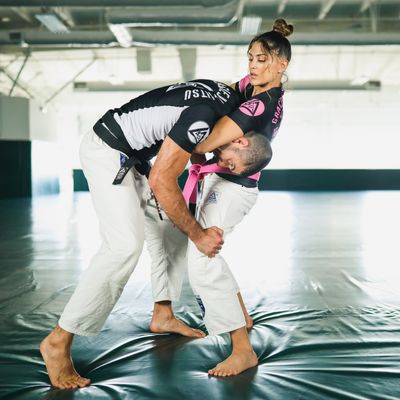
In 2007, Eve Torres Gracie won a nationwide WWE talent competition to seek out glamorous, strong, and stunt-defying female performers for the organization’s roster. At the time, Torres Gracie, a 23-year-old USC engineering graduate who had a background in gymnastics and dance, didn’t know much about wrestling. But she loved the sport’s spectacle and athleticism, its blend of theatrics and stunts, the inimitable thrill of the ring. She went on to become the WWE’s first three-time women’s champion.
Starting out in the WWE, Torres Gracie frequently found herself traveling from city to city at odd hours of the night, often alone and in her rental car. After a harrowing encounter with three men at a gas station, she realized she didn’t have a way to protect herself. “I’d always felt like someone who was confident and capable. I was a gymnast. I was ‘strong for a woman,’” she says. “At the same time, I recognized that in a situation like that, I had no clue what to do.”
A friend introduced her to Brazilian jujitsu, a self-defense martial art with origins in Japanese judo that was popularized in Brazil by brothers Carlos, Osvaldo, Gastao Jr., and Hélio Gracie a century ago. In its current form, BJJ offers a more practical approach to combat wherein you don’t have to be physically stronger or larger than your opponent to make them submit. When Torres Gracie showed up at her first class at the Gracie headquarters in California, taught by Hélio’s grandson, Rener, she was skeptical that self-defense could actually work against a dangerous opponent. But one session dispelled her doubts. “I was amazed by how it made me feel,” she tells the Cut. She was also angry that she had never been exposed to something as effective before.
Unlike other popular fighting styles, which can involve extensive counterattacking and pose the risk of tiring yourself out, BJJ focuses on leverage, positioning, and energy preservation. Torres Gracie knew she had to get this knowledge into as many women’s hands as possible, a challenging feat in a largely male-dominated sport: Women weren’t permitted to compete in the International Brazilian Jiu-Jitsu Federation until 1985, and women’s divisions weren’t formally created for the event until 1998; even as the number of women in BJJ rises, only about a fourth of the sport’s participants are estimated to be female. So she and Rener — whom she eventually married — went on to develop the Woman Empowered Self Defense Program, a 15-lesson course based on BJJ techniques and designed to help participants de-escalate common threats to women’s safety and break free from physical danger if those threats do escalate. Since launching in Torrance, California, in 2010, the program, the first to offer widespread beginner BJJ just for women, is now offered at 147 certified Gracie jujitsu centers around the world. “In our belief, you don’t feel confident enough to set boundaries or use your voice unless you have something to back it up,” Torres Gracie says. “The measure of victory isn’t how many women arm lock or choke out guys left and right.” It’s how many don’t need to fight because they asserted themselves before things got bad; how many used their voice to knock the target off their back.
_
Before getting into jujitsu, what drew you to the pro-wrestling world?
I loved athletics and performance, and wrestling combined both of those in a very challenging way. It was such a part of our pop culture growing up. When the opportunity came up to audition for Diva Search, I entered and ended up winning. I had no wrestling background and a lot to learn, but I loved the idea of this live theater mixed with stuntwork. It felt fun, exciting, and challenging. Anyone who has ever been to a wrestling event will understand why people are so passionate about it.
You started BJJ after feeling unsafe working and traveling alone. What led you to seek out that training?
When I started with WWE, I knew no one in that world. I was often traveling by myself. Most people don’t recognize the rigorous traveling WWE performers do. You’re leaving hotel rooms at 4 a.m. to get to the airport, driving from one town to another, leaving late at night, and arriving to the hotel at 3 a.m. in your rental car.
I felt very exposed. In the beginning, I had an incident where I was driving alone and had to pull over at a gas station to get snacks and water to get me through the drive. There were three men at the station. I was wearing flats, but I still had makeup on and was dressed in my show attire. And they targeted me, asking me questions and trying to get me to come with them. I didn’t know what to do, so I ignored them. That infuriated them. They continued to pursue me and actually got angrier. I remember looking at the guy who was working at the gas station. He gave me this look, like, I can’t help you. And I set everything down that I had and ran outside, and they followed me out. I got to my car, slammed the door, and drove off. I pulled over and just cried and cried. My heart rate was elevated. I was terrified — and I was by myself.
It was clear to me that I didn’t have a plan in that situation. So that’s where my journey began, in a situation that a majority of young women go through.
Why BJJ as opposed to other self-defense?
Honestly, I was kind of under the belief that self-defense wasn’t really going to help. In my mind, I was like, okay, I’m smaller than anyone I’m actually going to face. I might get lucky and get out of there, but ultimately, if I have to fight someone much bigger than me, how is that going to work?
It took someone inviting me into the experience to open me up to it. I had known about jujitsu because my brother trained in it in high school, but it was never something I was really exposed to other than him putting me in holds every once in a while. So my now sister-in-law invited me to my first class and kind of said at the same time, I want you to meet somebody. She slid that in there. I showed up to my first class, and Rener was teaching. I expected it to be fun and to learn something, but I didn’t expect the sense of empowerment I felt after that class. I felt like, This could actually work. I can actually defend myself against someone bigger than me. That was mind-blowing. So I was extremely drawn to the effectiveness and efficiency of BJJ. I also happened to be drawn to the man who gave me my first class, and we started dating after that.
What was the moment in that first class where things clicked for you?
I remember the first technique I learned, which is called the trap and roll: You’re on the bottom of the fight from a position called the mount. A person is mounted on top of you, knees pinned to either side of your body. The question is, how might you try to escape this? And I, feeling like I was strong and tough, was like, Oh, watch me! I’m going to show them how I can get out of here. I tried and tried but couldn’t get out. I realized I had no clue what to do and would just exhaust my energy and burn out. Then I learned that simple technique, where I trap my opponent by their body, bump my hips, and roll them off. It didn’t require me to be extremely strong or athletic. It almost felt like a self-defense hack. And that’s when I went, Oh my gosh, I never would have thought of that in a million years. I could have been here for hours and never would have put that together. I wanted to learn more. For every problem that was presented, for every self-defense scenario, there was this effective solution based on leverage or timing that worked. I became addicted to finding a solution to the problems presented. You fall in love with the process of: What other scenarios are there that I don’t know the answer to?
How did you decide to start the Women Empowered program?
When I first started training in jujitsu 16 years ago, there were at most two women in the class, and I was often the only woman in the advanced classes. So I felt like, why aren’t women learning this? The level of physical confidence that it gave me — it was something I didn’t feel I could keep to myself. But I also knew why women weren’t attracted to the sport. You walk in and everyone’s rolling around and sweating on each other. Not to mention the concern that you won’t be good at something, which comes up for a lot of people but for women in particular.
Rener and I decided we had to create a program just for women. At the time, the school had a women’s program that men taught, but it never took off. Women would show up and love it, but they never stuck around. We had to create a safe space for women to feel that jujitsu is for them. We developed a curriculum specific to women’s safety needs, taking into consideration the most common and dangerous threats facing women. For that we interviewed law enforcement, read accounts of survivors, and listened to the questions women brought up: What about this scenario? What about that scenario? We narrowed it down to about 20 lessons. Each one addresses a common attack, including rear bear hugs and chokes, weapon defenses, and wrist releases for when an aggressor is grabbing and pulling their target by the wrist. The program has evolved since, but the initial idea was a program for women where women can show up and feel comfortable training with other women.
What kinds of threatening scenarios were taken into account while creating the curriculum?
Violence against women is complex, but a lot of self-defense programs like to oversimplify the solutions to groin strikes, eye gouges, and aggressive tactics. Those can be effective, but it’s important for a program to have scalable solutions, because as we know, the majority of assaults or violence committed against women will be by someone known to them. If the only tactics we can pull from are these level-ten techniques, there may be some women who are going to be more reserved. So it’s not only about understanding the scenarios, but also understanding that there’s a variety of desired outcomes. A program meant to address women’s safety has to have everything from verbal assertiveness to boundary setting to threat neutralization, where there’s no escalation needed but we can use our voice to potentially reduce the risk of an assault continuing, all the way to to the other side of the spectrum, which is the worst possible thing you can imagine. Escape is not an option, and all you have is your body as a weapon. And you have to use it as a weapon and may need lethal-force options. We cover those as well.
We have tools for if you’re at a gas station feeling unsafe. Or if you’re pinned to the ground. A lot of what jujitsu addresses is when the fight goes to the ground; that’s what sets it apart from a lot of other martial arts. Ideally, we’d get to safety before that happens, but statistically, fights often go there. So we have to know how to get back up on our feet, or if that’s not an option, how to potentially defeat somebody from the bottom.
What are the demographics of Women Empowered participants? What brings them to class?
We’ve got everyone from young girls who are 11 and 12 years old to their moms and grandmothers. We have women who say, if you told me five years ago I would be training jujitsu, I would not have believed you. Our students come from all different backgrounds, and we do have a high number who have experienced trauma or violence and come to us. Unfortunately, that’s going to be any roomful of women you walk into, but specifically for what we do, it will be skewed toward the higher end. It’s often why they are there, to seek healing or safety.
I remember this woman who was brutally attacked on the beach. She was running and was pushed face down into the sand. She was sexually assaulted and beat up very badly. She survived. The police department reached out to us and asked, once she heals, is this someone we would train? We said absolutely, send her to us. She started training with us regularly. Of course, there were difficult moments. But one of the most beautiful things was a letter she later wrote to us. She said, I would have nightmares, nightly or weekly, about the incident. I couldn’t stop having nightmares. I finally defeated the guy in my dreams, and I haven’t had nightmares since.
Have the pink belts you’ve trained ever used the techniques you teach them in real life?
We get the most reports on boundary setting. So many women say, the exact scenario we practiced came up, and the person responded as we role-played. One of our students told us a man was approaching her while she was by herself in a parking lot. She yelled at him, “Excuse me, sir, stay right there!” She told us he thought she was law enforcement because of her strong tone, and once he walked away, she got back into her car to safely drive away. Another one of our students once came to class shaken up; the day before, a man walked into her condo through the back door while she was alone. She thought it was her partner. She kept her distance with her hands up and shouted at him to get out, scanning for her exit. At first, he didn’t move, so she escalated louder. He appeared startled by how forceful and determined she was with her voice and tone and ran out. Those are the ones I’m so proud of and happy to hear, because in an ideal world, the ability to assess danger, set boundaries, and set distance will hopefully reduce the likelihood of the threat going further.
When we role-play boundary setting in class, that might look like someone is approaching you and you get a gut feeling that something doesn’t feel right. The first thing we do is keep distance, if possible. Setting boundaries might look like turning toward them, putting our hands up in an open stance, making eye contact, giving them a clear direction. Say exactly what you want the outcome to be. It might sound something like, Excuse me, stop right there. Don’t come any closer. You’re not saying, Hey what do you want? It’s stop right there.
Depending on their response, we may have to escalate all the way to yelling at the person and drawing attention. We believe in scalable boundary setting, because not everyone will feel comfortable dropping into a stance and yelling “stop.” So we give them ways to escalate if a stranger shows you they’re not respecting your initial boundaries. For some women, that can actually be the most challenging class they take: learning how to confidently look someone in the eye and tell them to stop and not to come any closer, and to say it like they really mean it. We’re often taught to prioritize other people’s levels of comfort and feelings over our own safety. So that class is really about recognizing: Why don’t we do this? Why wouldn’t we? Oftentimes it comes back to people going, Well, I don’t want to be mean. I don’t want to hurt their feelings. Or: What if they’re a nice guy?
I don’t think I’ve ever set a boundary like that. The fear of someone getting angry is also a deterrent.
That’s another concern for a lot of women.
So what do you do if someone does get angry?
I think back on my scenario at the gas station. I didn’t say anything. I ignored the men completely, and that’s really what made them angry, what made them feel they could prey on me. We have to think about, what is their desired outcome? If they had bad intentions, their desired outcome would be for me not to say much, to be meek so they could continue. So in a situation like that, I would just answer their question. When they say, Hey, girl, what are you doing tonight? I would just say, Oh, I’m driving. Gotta get out of here. Have a good night! I would have answered their question, looked confidently at them, and be very clear without inviting further conversation. I will never know what would happen differently, and I don’t think we should think about things that way. I did the best with what I had at the time. But I’ve been in so many different scenarios since. I was once at a park and a man drove close to me, asking me for help and directions. I looked at him and his car and calmly but assertively said, “I can’t help you” and started walking away. Another time, I was out with my girlfriends, and an intoxicated guy was intruding on our space and conversation, and on one of my friends in particular. I physically blocked off his ability to reach her and said, “It looks like you’re having a good time. My friends and I haven’t seen each other in a while and we’d like some space.” He didn’t escalate or anything; he just walked away. My ability to address people verbally and confidently will often make them go, Oh, nope, this isn’t the target that I want.





